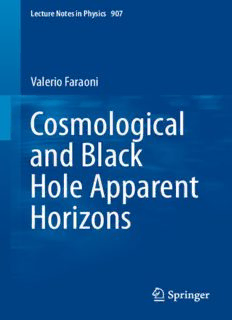
Cosmological and black hole apparent horizons PDF
Preview Cosmological and black hole apparent horizons
Lecture Notes in Physics 907 Valerio Faraoni Cosmological and Black Hole Apparent Horizons Lecture Notes in Physics Volume 907 FoundingEditors W.Beiglböck J.Ehlers K.Hepp H.Weidenmüller EditorialBoard M.Bartelmann,Heidelberg,Germany B.-G.Englert,Singapore,Singapore P.Hänggi,Augsburg,Germany M.Hjorth-Jensen,Oslo,Norway R.A.L.Jones,Sheffield,UnitedKingdom M.Lewenstein,Barcelona,Spain H.vonLöhneysen,Karlsruhe,Germany J.-M.Raimond,Paris,France A.Rubio,Donostia,SanSebastian,Spain S.Theisen,Potsdam,Germany D.Vollhardt,Augsburg,Germany J.D.Wells,AnnArbor,USA G.P.Zank,Huntsville,USA TheLectureNotesinPhysics The series Lecture Notes in Physics (LNP), founded in 1969, reports new developments in physics research and teaching-quickly and informally, but with a high quality and the explicit aim to summarize and communicate current knowledge in an accessible way. Books published in this series are conceived as bridging material between advanced graduate textbooks and the forefront of researchandtoservethreepurposes: (cid:129) to be a compact and modern up-to-date source of reference on a well-defined topic (cid:129) to serve as an accessible introduction to the field to postgraduate students and nonspecialistresearchersfromrelatedareas (cid:129) to be a source of advanced teaching material for specialized seminars, courses andschools Bothmonographsandmulti-authorvolumeswillbeconsideredforpublication. Editedvolumesshould,however,consistofaverylimitednumberofcontributions only.ProceedingswillnotbeconsideredforLNP. Volumes published in LNP are disseminated both in print and in electronic formats, the electronic archive being available at springerlink.com. The series contentisindexed,abstractedandreferencedbymanyabstractingandinformation services, bibliographic networks, subscription agencies, library networks, and consortia. Proposals should be sent to a member of the Editorial Board, or directly to the managingeditoratSpringer: ChristianCaron SpringerHeidelberg PhysicsEditorialDepartmentI Tiergartenstrasse17 69121Heidelberg/Germany [email protected] Moreinformationaboutthisseriesathttp://www.springer.com/series/5304 Valerio Faraoni Cosmological and Black Hole Apparent Horizons 123 ValerioFaraoni PhysicsDepartment Bishop’sUniversity Sherbrooke,QC,Canada ISSN0075-8450 ISSN1616-6361 (electronic) LectureNotesinPhysics ISBN978-3-319-19239-0 ISBN978-3-319-19240-6 (eBook) DOI10.1007/978-3-319-19240-6 LibraryofCongressControlNumber:2015943318 SpringerChamHeidelbergNewYorkDordrechtLondon ©SpringerInternationalPublishingSwitzerland2015 Thisworkissubjecttocopyright.AllrightsarereservedbythePublisher,whetherthewholeorpartof thematerialisconcerned,specificallytherightsoftranslation,reprinting,reuseofillustrations,recitation, broadcasting,reproductiononmicrofilmsorinanyotherphysicalway,andtransmissionorinformation storageandretrieval,electronicadaptation,computersoftware,orbysimilarordissimilarmethodology nowknownorhereafterdeveloped. Theuseofgeneraldescriptivenames,registerednames,trademarks,servicemarks,etc.inthispublication doesnotimply,evenintheabsenceofaspecificstatement,thatsuchnamesareexemptfromtherelevant protectivelawsandregulationsandthereforefreeforgeneraluse. Thepublisher,theauthorsandtheeditorsaresafetoassumethattheadviceandinformationinthisbook arebelievedtobetrueandaccurateatthedateofpublication.Neitherthepublishernortheauthorsor theeditorsgiveawarranty,expressorimplied,withrespecttothematerialcontainedhereinorforany errorsoromissionsthatmayhavebeenmade. Printedonacid-freepaper SpringerInternationalPublishingAGSwitzerlandispartofSpringerScience+BusinessMedia(www. springer.com) TomysistersAdrianaandLilly Preface Currently, substantial research efforts are devoted to understanding the physics of horizons. A horizon is a surface which separates a region of space-time which is accessible to an observer from one which is not and from which this observer cannot receive light or other physical signals. This feature gives rise to interesting physics:withtheemphasisgiveninmoderntimestotheroleplayedbyinformation in theoretical physics, it is easy to guess that a horizon will produce interesting physicalphenomena.Ifentropyisunderstoodasinformationentropy,thenahorizon which hides information should be attributed some entropy. This is in fact what the black hole thermodynamics developed in the 1970s found. The discovery of Hawking radiation from black hole horizons made possible the development of black hole thermodynamics, a remarkable and beautiful construct which shows that, indeed, there is very interesting physics associated with horizons. Already in special relativity without gravity, uniformly accelerated observers experience acceleration horizons. When gravity is introduced, one encounters black hole and cosmologicalhorizons.Then,studyingblackholes,onemeetsinner,outer,Cauchy, and extremal horizons, and in cosmology there are particle, event, de Sitter, and apparenthorizons. The pioneers who developed black hole mechanics and thermodynamics in the 1970s discussed stationary black holes and event horizons. Dynamical situations such as gravitational collapse, black hole evaporation by Hawking radiation, and black holes interacting with nontrivial environments and exchanging mass-energy require that the concept of event horizon be generalized. Conceivable dynamical situations include black holes accreting surrounding fluids, black holes immersed in a cosmological background, and, most significantly, black holes emitting (and possibly absorbing) Hawking radiation, which becomes significant in the last evolutionarystages.Ifablackholeisplacedinanontrivialenvironment,itsmass- energyshouldbealsotheinternalenergywhichweneedtoaccountforinthefirst law of thermodynamics. This mass-energy must be defined carefully, usually with somequasi-localnotion,whichinturnissometimesrelatedtothenotionofapparent horizon. vii viii Preface In dynamical situations, it is not clear what is meant by “black hole” because the most salient feature of a black hole is precisely its horizon, and the event horizon familiar from stationary black holes turns out to be essentially useless for practical purposes in dynamical space-times. This major obstacle appears because thedefinitionofeventhorizonrequirestheknowledgeoftheentirefutureofspace- time, which is physically impossible to achieve in nonstationary situations. The ambiguityinthenotionof“horizon”thereforeimpliesmurkinessintheconceptof “black hole” itself.Simultaneously, thanks totheincrease inthe power of modern supercomputers, great theoretical efforts are now made to predict in detail the waveforms of gravitational waves emitted by black holes. These waveforms are needed to build banks of templates to separate signals from noise in the laser interferometric detectors of gravitational waves. The notion of event horizon is of little use in the numerical study of fast astrophysical processes producing those gravitational waves. Instead, “black holes” are routinely identified with outermost marginally trapped surfaces and apparent horizons in numerical research. Hence, a part of the research community is still focused on event horizons, while another part dismisses it altogether and uses horizon surfaces, the role of which is not yet understoodclearly.Thisdichotomyneedstobeaddressed,andthisworkisintended togiveacontributioninthisdirection. This book contains a series of graduate-level lectures introducing the main problemsinthisareaoftheoreticalphysics.Thefirstthreechaptersarepedagogical in nature, while the remaining two report a series of “case studies” to which the concepts of apparent and trapping horizon are applied. They consist of relatively rare analytic solutions of Einstein’s theory and of scalar-tensor and f.R/ gravity whichappearedintheliteratureandcontain,atleastincertainspace-timeregions, blackholeandcosmologicalapparenthorizons.Thedynamicsofapparenthorizons canberatherbizarreandreservesseveralsurprises.Thephenomenologyofapparent horizons known thus far is described and analyzed. While this field of research is definitely not settled and the last word is not said on any of the issues examined, theselecturesaimatcollectingandsummarizingtheexistingresultsandproviding an introduction and a toolkit for researchers approaching this field, especially graduate students. An extensive bibliography refers the reader to specific points which cannot be discussed in a single volume. I hope that these lectures will be stimulatingandthatsomeofmyreaderswillsoonfindnewdirectionsforthisarea ofresearch. Sherbrooke,Canada ValerioFaraoni April2015 Acknowledgments Iamindebtedtomanypeoplefortheircontributionstothematerialdiscussedinthis book,andmythanksgofirstofalltomycollaboratorsandtomystudents:Thomas Sotiriou,VincenzoVitagliano,StefanoLiberati,AngusPrain,AlexNielsen,Audrey Jacques,AndresZambrano,andRoshinaNandra. Fordiscussionsorcomments,orfortheoccasionale-mailpointingoutreferences that I missed, I am grateful to Hideki Maeda, Matt Visser, Daniel Guariento, JohnBarrow,EricPoisson,IvanBooth,LucianoVanzo,SergioZerbini,Rituparno Goswami, Bibhas Majhi, Andrzej Krasin´ski, Kayll Lake, Viqar Husain, Timothy Clifton, Sergei Odintsov, Emilio Elizalde, Sebastiano Sonego, Nemanja Kaloper, Bahram Mashhoon, Salvatore Capozziello, Valeri Frolov, Sarah Shandera, Carlos Herdeiro, José Senovilla, and Rong-Gen Cai. Many thanks to Angus Prain for drawingthefiguresandtoAldoRampioniandKirstenTheunissenofSpringerfor theirsupportandfriendlyassistanceduringthewritingofthisbook. This research is supported by Bishop’s University and by the Natural Sciences andEngineeringResearchCouncilofCanada. ix
Description: